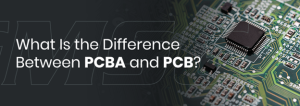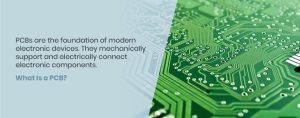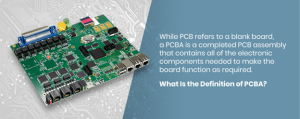
What Is the Difference Between PCBA and PCB?
Printed circuit board (PCB) and printed circuit board assembly (PCBA) are both important terms in the electronics industry. Some people use them interchangeably, but they are actually two distinct things.
The main difference between these two terms is that PCB refers to a blank circuitry board, while PCBA refers to a board that contains all of the necessary electronic components for the board to function as needed. A PCB is not yet functional because it does not have the required components in place, while a PCBA is a complete and functional board. PCBs and PCBAs are two different parts of the same process — a PCBA is built on top of an existing PCB.
In this guide, we’ll take a closer look at the definition of PCB, the definition of PCBA and the differences between the two terms.
What Is a PCB?
PCBs are the foundation of modern electronic devices. They mechanically support and electrically connect electronic components. The boards themselves are made of laminate material, such as fiberglass or composite epoxy, and contain conductive pathways that connect different parts of the board. These pathways are printed or inscribed onto the board according to the predetermined PCB design.
Types of PCBs
The main types of PCBs include:
Single-layer PCBs are the simplest type of PCBs and are coated with a single layer of conducting material and a layer of solder mask. The PCB’s components are marked with a silkscreen.
Double-layer PCBs have a layer of conducting material on both the top and bottom of the board, which gives them more flexibility and a smaller size than single-layer PCBs.
Multi-layer PCBs have more than two conductive layers and are used in more complex applications.
Other common types of PCBs include flexible PCBs, rigid PCB, and flex-rigid PCBs.

Materials Used
The substrate material for PCBs is usually fiberglass, composite epoxy or another laminate material. The conducting material on one or both sides of the board is most often copper. The printed circuits, which are plated or etched onto the substrate according to the design, are also made of copper. The circuits are coated with tin-lead to prevent oxidation. PCBs have contact fingers on their outer edges, which are also coated with tin-lead, as well as other materials, such as nickel and gold, to increase conductivity.
Applications
PCBs are used in a wide range of electronic devices, including consumer electronics, heavy machinery, robotics, vehicle components and medical equipment. Examples include:
• Computers
• Cell phones
• TVs
• Radios
• Printers
• Calculators
• Appliances
• Lighting systems
• Medical imaging systems
• Pacemakers
• Engine management systems
• Industrial controls
• Telecom towers
• Data storage equipment
• Satellite systems

What Is the Definition of PCBA?
While PCB refers to a blank board, a PCBA is a completed PCB assembly that contains all of the electronic components needed to make the board function as required. PCBA may also refer to the process of assembling the board with the necessary components.
There are two main methods that a PCBA company may use for PCB assembly:
1. Surface-Mount Technology
Surface-mount technology (SMT) is an assembly process that involves mounting electronic components to the surface of a PCB. It is highly automated and flexible, and it allows for higher connection densities. It enables manufacturers to place complex circuitries into small components.
The four basic steps of PCBA SMT are:
Preparing the PCB: First, the assembler places solder paste where it is needed on board.
Placing the components: Next, the assembler places the components on the board, typically using a pick-and-place machine.
Reflow soldering: The assembler then heats the boards in a reflow oven until the solder paste reaches the temperature required for the solder joints to form.
Inspection: The assembler conducts inspections throughout the SMT process, including before attaching the components and before and after reflow soldering.
2. Thru-Hole Technology
Thru-hole technology is an assembly process that involves drilling holes into a PCB through which electronic components called leads can be attached. It is an older technology than SMT but creates a stronger connection between the board and the components, which makes for more durable and reliable assemblies.
Thru-hole assembly can be either fully automated or semi-automated. The steps of the PCBA thru-hole process include:
Drilling the holes: The first step in the thru-hole process involves drilling holes into the board. These holes must be the right size for the component leads.
Placing the leads: Next, the assembler places the leads in the holes.
Soldering: The next step in the process is soldering. This step ensures the components are held firmly in place.
Inspection: Throughout the process, the assembly undergoes inspections to ensure the PCBA will function as expected.
How Do PCBA and PCB Relate to Each Other?
PCB and PCBA are the results of two different steps of the same overall process. A PCB is a blank circuit board with no electronic components attached, while a PCBA is a completed assembly that contains all of the components required for the board to function as needed for the desired application. A PCB is not yet functional, while a PCBA is ready to be used in an electronic device.
Manufacturing a blank board is a simpler process than producing a completed PCBA because of the various components and processes involved in PCB assembly. It also costs more to produce a PCBA than a blank PCB. However, both steps are necessary to create a completed board. You cannot create a PCBA without a PCB. PCB manufacturing is the first step in the process, and PCBA manufacturing builds upon that first step.
Another difference lies in how PCBs and PCBAs are packaged. PCBs are typically packaged using vacuum-packaging, while PCBAs require the use of compartmental or anti-static packaging.
Our PCBA Services
At DYC, we provide expert PCB assembly services, including board-level and completed box build assembly, SMT and thru-hole technology, and everything from fully automated processes to precise hand assembly. When you work with DYC, you get years of experience on your side, timely service and product excellence. To learn more about how our PCB assembly services can help you meet your goals, contact us online, call us at +086-0755-23576064 or request a free, no-obligation quote today.
